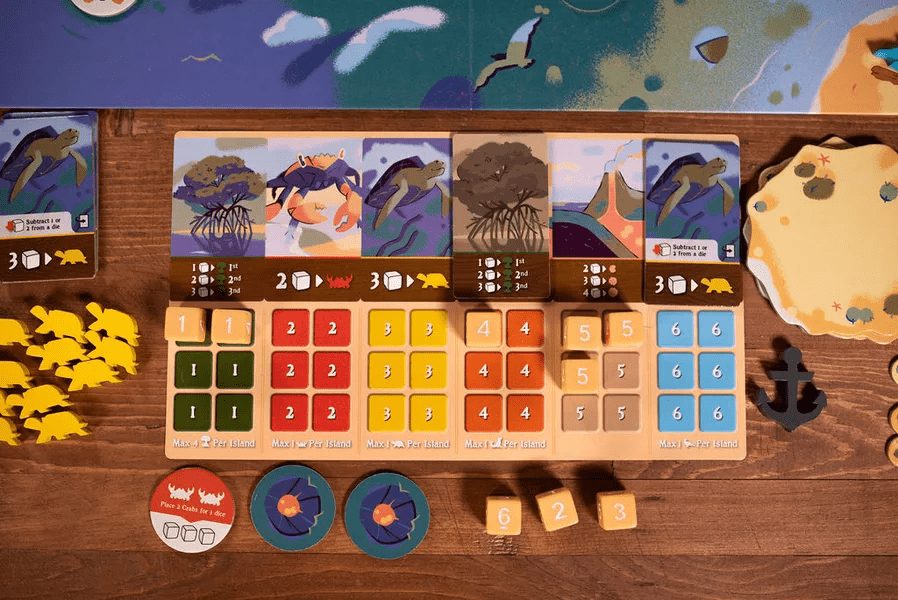Ecology Can Be Fun
Emerge puts you and up to three other players in the role of scientists studying a newly discovered chain of islands. Researching these locations’ plants, animals, and earth will uncover new islands and species that help each island grow and evolve. By the end of the game, the scientist who discovers the most islands and diverse wildlife will take home the victory. Admittedly, it’s not a very “sexy” premise for a board game, but there’s a sort of whimsical charm in a board game tackling such an intricate topic.
Each round in Emerge, players will roll an increasingly larger pool of six-sided dice and assign them to their player board to take research actions. Everyone starts with the same research board, but throughout the game, everyone’s boards will slowly change and morph to facilitate each player’s unique strategy. At the end of eight rounds, players score points based on how many islands they found, how big each island is, how diverse the ecosystem is, and how many research objectives they completed. Those eight rounds go by surprisingly fast, with our games usually finishing around the one-hour mark.
Wildlife Wonders
I was immediately delighted by Emerge’s visual language. The game is strikingly gorgeous and has an apparent color scheme and design aesthetic. I could almost hear the waves lapping at the shoreline and the gulls squawking above me as we played the game. The main gameboard is a deep blue and green to evoke the seafoam island imagery. Each player board is color-coded to match player pieces and islands, and the colors feel right at home in the tropical world of Emerge rather than the generic red, blue, and yellow pieces you’ve seen in other games.

The pieces themselves are delightful as well. Each player receives four islands in three different sizes, and every island is cut out of the cardboard with ever-so-slightly different edges. At first, I thought this would drive me crazy since you’re unable to stack all the islands in a pile neatly, but I came to appreciate how it added to the game’s brand. You can stack your island pieces to grow them into larger, three-dimensional islands, and the tiered islands create a neat visual trick where the various animals and plants can rest at different elevations. It doesn’t impact gameplay but shows again where Emerge is committed to its unique visual brand.
Speaking of those plants and animals, let’s talk meeples! Emerge comes with over 80 brightly-colored wooden meeples to help populate your island. Green trees, yellow turtles, orange seals… oh my! These brightly colored bits of the ecosystem are more than just eye candy; they also help facilitate gameplay by allowing you to identify what pieces each island is missing. It also comes with 40 dice, 10 for each player, in bright colors that match the player boards. These dice are chunky and an absolute delight to roll every round. When the final round hits, you’re rolling all 10 of your dice, and it’s always a good time.
Dice and Discovery
Gameplay in Emerge takes place over three phases, but the lion’s share will occur during the third phase. The first phase, dubbed the “Ship Phase,” is pretty straightforward: move the ship meeple down the turn track on the board. When it moves to a new space, you uncover the face-down research tokens next to it on the new area, showing off what one-time bonuses can be collected if a player builds an island there. Everyone adds one more die to their dice pool if the boat passes over a die icon. Players start with six dice and gradually build up to a total ten-dice collection.
The second phase is the “Modifier Phase”. As a free action, every player can grab a modifier tile from the communal pool and place it on their research board. Though this phase is relatively short, it is where the bulk of the divergence in strategy between players will occur. The modifier tiles are all repeats of the six default action spaces on the research board, but by placing a new one, you can cover up one action to replace it with another. The benefit here is that you have more opportunities to perform the action you want at the cost of not having access to the action underneath. But don’t worry: In future phases, you can move your modifiers around or return them to the supply. You can only have two of the same action at any given time, so one player can’t have all their spaces on the same action.

Finally, the third phase is “Discovery”. During this phase, all players roll their pool of dice and assign the numbers to the matching spots on their research boards. Each modifier tile has a one-time use ability to let you modify your dice by bumping a die up or down by one or sacrificing one die to set another to the value you want. Once all the dice have been placed, players take turns paying dice to perform actions on their board. You can take six primary actions, which all require spending some amount of matching numbered dice. Three of the actions involve discovering new species of aquatic life on the island; one lets you grow plantlife, another enables you to discover a new island or add another layer to an existing island, and the final lets you fly in birds to your island. There are intricate interactions between these choices. For example, adding plants to your island starts cheap but gets more expensive with more trees on your island. You need plants to add any of the three essential animals to your island, while birds can fly there without existing plant life and even plant you a tree for free (but are at risk of being stolen away by your opponents). Some of the actions make sense thematically, such as discovering more layers to your island the longer you study it, as it rises from the sea. Some rules are more abstract, such as not having seals unless you have turtles and no turtles unless you have crabs. It’s all about the vibe. Just go with it.
While you score points for the number of meeples on each island multiplied by the number of layers on the island, the chance to get ahead comes from the unique research objectives. Four are chosen randomly in each game, which gives Emerge its variability between plays. These goals award one-time bonuses for each player who completes them, but achieving them first will net you more points than those who complete them later. Some goals are straightforward, such as planting three trees in one turn. Others are difficult and require several setup turns, such as stealing a bird from someone else’s island twice in one round. The research tokens you pick up along the way can give you one-time bonuses to help you achieve these goals, but the tokens themselves are worth extra points if you keep them until the end of the game, providing a nice tension in decision-making.
Closing Thoughts
Emerge is one of the prettiest games to hit my table in a long time. Every aspect of the game shows off the incredible design and aesthetic and immerses you in the game’s world. We sat around the table after finishing our first game, examining the fun meeples and card art. It’s a bright, colorful game that invites you to explore all it offers.

That being said, after a few plays of it, I can’t help but wonder how much depth it has to offer. Ironically, a game about exploring uncharted waters for hidden islands in the depths winds up feeling a bit shallow. Every player’s board may look different, but it doesn’t feel that different to play. People’s strategies depend wholly on the dice they roll, so you’re never really taking a proactive role in determining how you will score points. Simply roll the dice, see what you have, and take the best possible route. While this reactive playstyle is acceptable for a board game, Emerge doesn’t give you many interactive tools to stop other players who high roll, nor does it have enough ways to fix your dice if you get a nasty roll. This is, of course, the nature of a “dice game.”
But if you can look past the reactive nature of the dice rolls, you’ll find a lovely visual treat that plays in a very nice hour-ish window. The blend of semi-simultaneous turns during the first two phases and the sequential turns in the discovery phase keeps the game flowing quickly. To its credit, every round of Emerge has been extremely close. Nobody ever feels truly out of contention, and many games have come down to a one-point margin of victory, meaning those research tokens you decided to keep along the way matter and have a tangible impact on the game. It’s a pleasant, low-complexity game that’s easy to teach and won’t take up a whole afternoon. It has earned its spot on my shelf. Despite my few nitpicks with the dice fixing, I’ve enjoyed escaping to the islands of Emerge and look forward to bringing it back out to teach my more casual game groups.











Add Comment